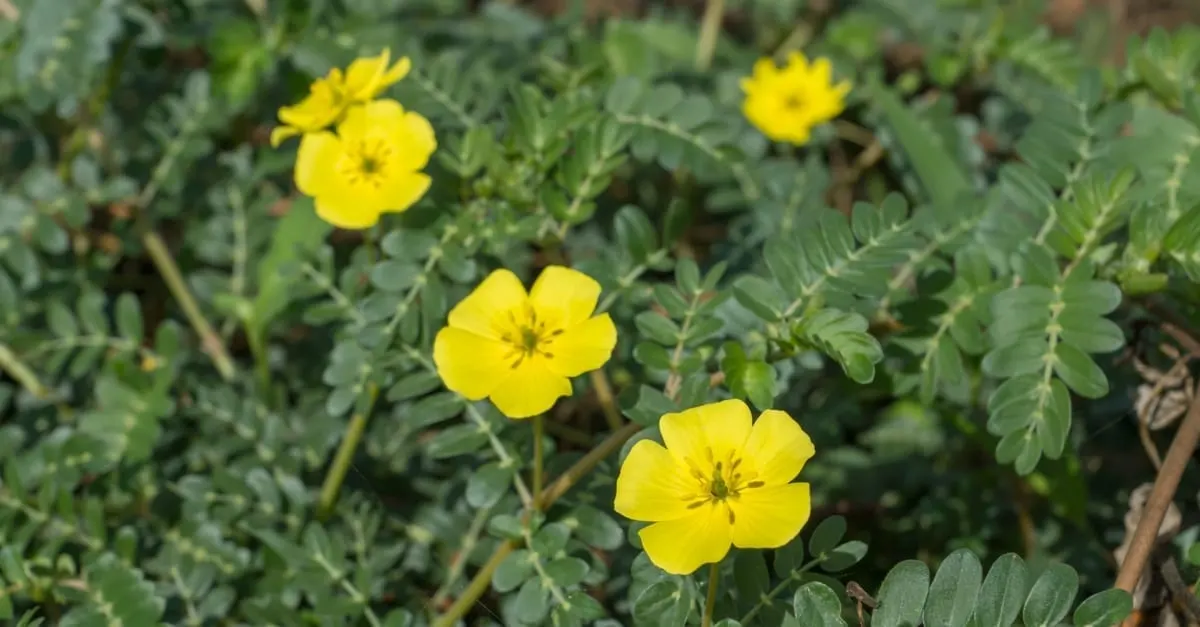Goat head weed is an annoying, invasive species of weed that is extremely painful to step on and hard to kill.
Fortunately for you, we’ll cover what this weed is and how to get rid of it.
Read on to learn more.
What Is Goat Head Weeds?
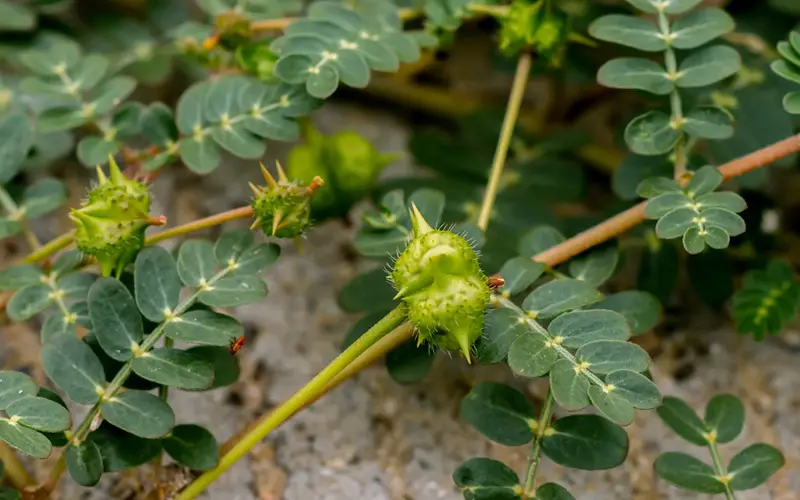
NOPPHARAT9889/Shutterstock
Goat head (scientific name: Tribulus Terrestris) is also commonly known as puncturevine.
That’s because of the way goat head burrs penetrate clothing, gloves, footwear, tires, and, of course, skin.
Stepping barefoot on a goat head burr drives one of its two long, upright thorns into the sensitive bottom of the foot. This produces sharp pain and can lead to infection.
Often, people get additional punctures when they try to remove the thorn from their foot or hand.
People can also get hurt when they encounter goat heads tangled in pants, socks, shoelaces, or a pet’s fur.
Why Goat Head Weed Is a Pain
Balls that roll into a patch of goat heads may come up covered with spikes. Many people have learned the hard way to deal with goat head burrs by picking them out with pliers, tweezers, or heavy gloves.
They can also be removed by brushing or scraping. Bare fingers are not recommended. To make matters worse, goat head plants are toxic to livestock.
While goats can reportedly graze on it without harm, it’s poisonous to sheep and possibly cattle. This harmful effect is in addition to the cuts on the animals’ mouths that are likely when they try to eat it.
Oddly enough, dried and ground goat head seeds are used as a remedy in traditional Chinese and Ayurvedic medicine.
It’s marketed in Western countries as an enhancer of testosterone, male libido, and sports performance. Regardless, the burrs of the goat head plant are needle-sharp and hard enough to puncture bicycle tires and some shoe soles.
And these non-native weeds are invasive and hard to kill. Once established on a lawn, garden, or pasture, goat head is a hazard to people, pets, and livestock, as well as causing flat tires.
But with a systematic and sustained attack, it’s possible to beat goat heads and make a landscape safe for barefoot walking again. Read on to learn how to eradicate these annoying weeds for good.
Goat Head Weed Description
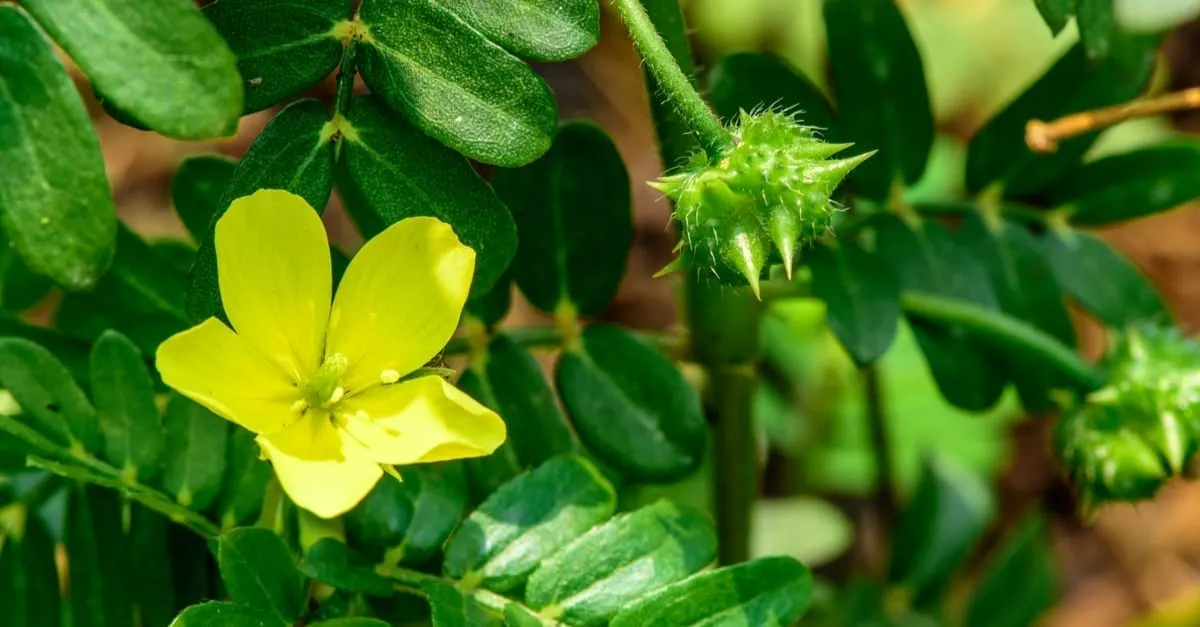
Pisitpong2017/Shutterstock
The goat head is native to southern Europe and the Mediterranean region. It’s been distributed over much of the world, however, likely through imported livestock.
In North America, it has been reported in almost every one of the Lower 48 states. It also grows in parts of Canada. The plant is an annual that does well in hot conditions and dry, gravelly soil.
It’s commonly found on roadsides, in fields and pastures, and along railroad tracks. It grows in a low, dense mat that spreads rapidly by hairy vines up to three feet or so in length.
It crowds out many native plants. The leaves are also covered with hairs and grow in pairs on opposite sides of the vine stems. Flowers are a quarter-inch or so across and bright yellow.
The problem is the fruit. The tan, hairy fruits split into four nutlets when they mature. Each nutlet bears two long, sharp spines and several shorter thorns. The nutlets look like the heads of goats with their long, protruding pairs of thorns.
When lying on the ground, the goat-like thorns point up, perfectly poised to stab into the feet. Each plant can produce up to 5,000 of these agony-producing burrs in a single season.
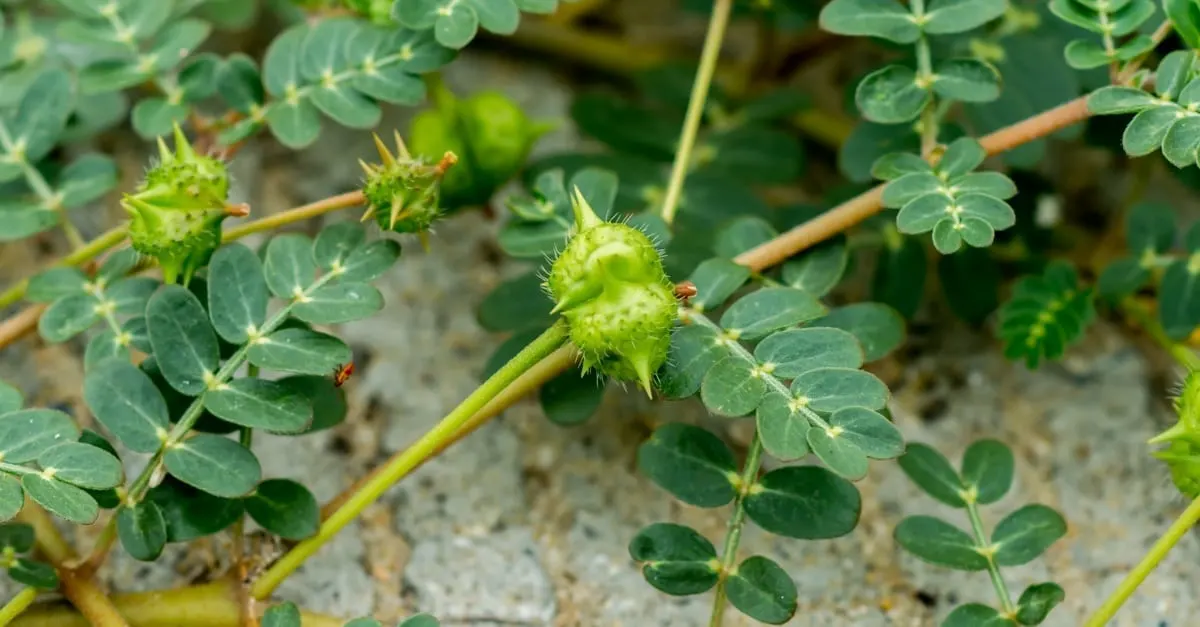
Noppharat689/Shutterstock
And each burr that sticks in a shoe, tire, or pet’s fur can be transported to another location and create a new infestation. Not surprisingly, many states classify goat head as a noxious weed.
A few small cities in the Pacific Northwest have offered bounties to people who bring in garbage bags full of uprooted plants. Wherever it’s found, goat head has a poor reputation.
Here are some of the other common names it has around the world:
- Bhakhdi (India)
- Bindii (New Zealand)
- Bullhead
- Burra gokharu
- Caltrop (a spiked weapon used to injure cavalry horses that step on it)
- Cat’s-head
- Devil’s eyelashes
- Devil’s-thorn
- Devil’s-weed
- Tackweed
Just considering the meaning of these names gives you a good idea of how well-regarded goat heads are.
How to Get Rid of Goat Head Weeds
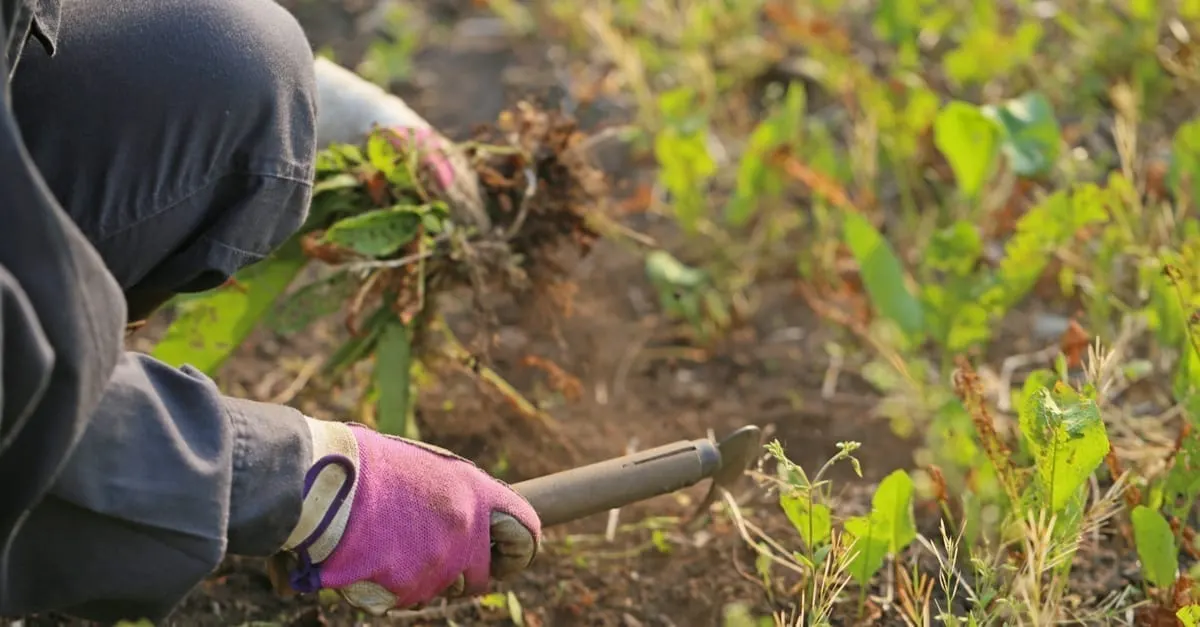
Kelly Marken/Shutterstock
Goat head weed is very difficult to eradicate from a landscape. The main problem is that the seed pods can remain capable of germinating for up to seven years. To get rid of goat heads requires a long-term effort.
It may also require the willingness to use chemical pesticides as well as manual removal and other techniques. It’s best to avoid getting goat heads into a landscape.
If goat head grows in your area, try not to track it in on shoes or clothing. This can be easier said than done, however. Goat head burrs can be transported to your property on the tires of delivery trucks or other vehicles.
If you see goat heads growing, take steps to get rid of them before they go to seed. Remember: The seeds remain fertile for several years. Mowing won’t work, however, since the plant grows flat against the ground.
Pulling the Weed
Manually pulling up the weeds can be useful, but gardeners have to be sure to get the root. Some gardeners use hoes, weed diggers, claw hammers, and even pliers to get goat heads up without risking injury from the thorns.
Lawn jaws are often mentioned as a useful goat head pulling tool. After removing the plants, it’s necessary to pick up as many thorns as possible. This can be done by sweeping or vacuuming.
Some goat head eradicators recommend dragging an old sheet or piece of carpet over the ground to pick up burrs. Others say walking over the ground with flip-flop sandals will get the burrs up.
Unfortunately, it’s challenging to get all the roots and burrs. So goat heads may come back next season or even years later. It may be necessary to remove it and sweep again. And perhaps again.
Goat Head Herbicides
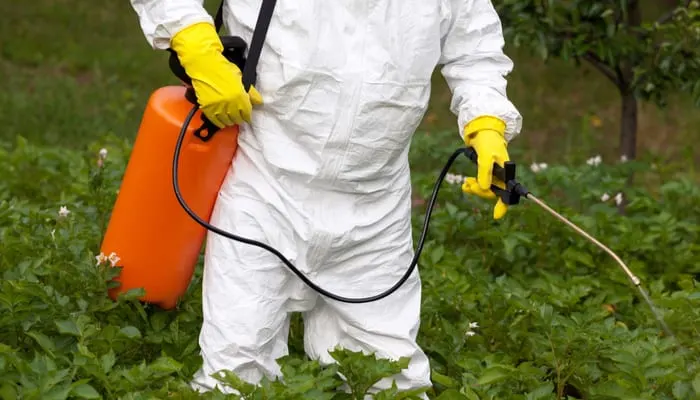
Wellphoto/Shutterstock
Many gardeners use chemical poisons to kill goat heads. However, even modern pesticides have to be used just right to get rid of this weed.
Use pesticides containing oryzalin or trifluralin in the late winter and early spring. Applying these pre-emergent herbicides before weeds sprout prevents the plants from getting started.
After the plants are sprouted, pesticides containing glyphosate or dicamba will kill the actively growing goat head weed. Note that Round Up, which contains glyphosate, has been identified as a probable carcinogen in some studies.
BurnOut is a weed killer made from natural ingredients that some have reported works well on goat head weeds. It’s a broad-spectrum pesticide that will kill nearly any weed or grass.
After the weeds are dead, it’s crucial to remove them and clean up any thorns. These pesticides will probably kill some but not all the goat heads. As with manual removal, it may have to be repeated more than once.
Burning Goat Head
If you have a sizable area infested with goat heads, you may want to consider literally burning them out. A propane torch doesn’t pollute the environment. It is less labor-intensive than manually pulling.
And it will kill both leaves and seeds. On the downside, igniting a weedy area with a flaming torch means risking an accidental burn. There’s also the chance of wildfire.
Check with your local fire department to see if you need a permit. Also, the torch kills everything, burning all plant life down to the dirt when appropriately used.
And still, it may not eradicate the goat’s roots. If you decide to go this route, consider the Red Dragon VT 2-23 C. This is the most highly rated propane weed torch.
Biological Controls
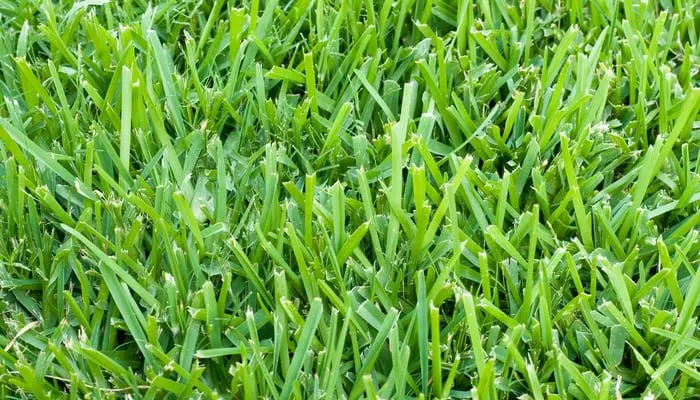
Tammykayphoto/Shutterstock
One all-natural way to handle goat head infestations is by planting native species that will outcompete them. Broadleaf grasses such as St. Augustine can choke out goat heads without the need for pesticides or hard labor.
Goats are also said to be happy to snack on goat head weed. They will chew plants to the ground but won’t usually get the roots or the spiky thorns. So goat head is likely to come back again next year.
Desert iguanas, which are native to the American Southwest, may also help. These lizards eat the flowers of goat head weeds. That keeps the fruit and, therefore, burrs from forming.
Finally, certain weevils feed off goat heads. The female weevils bore holes in the goat head seeds and laid eggs inside. The weevil larvae eat the seed contents, preventing them from germinating.
You can purchase Microlarinus lareyni weevils online. With luck, you can introduce them into your goat head patch, and nature will take care of it.
It can take a few growing seasons for weevils to have much impact. And they are unlikely to eradicate goat head, although they can help manage it completely.
Also, the infertile burrs will still be lying around for you to step on. But this biological approach is one more tool in the battle against goat head.
The Easy Way – Call a Pro
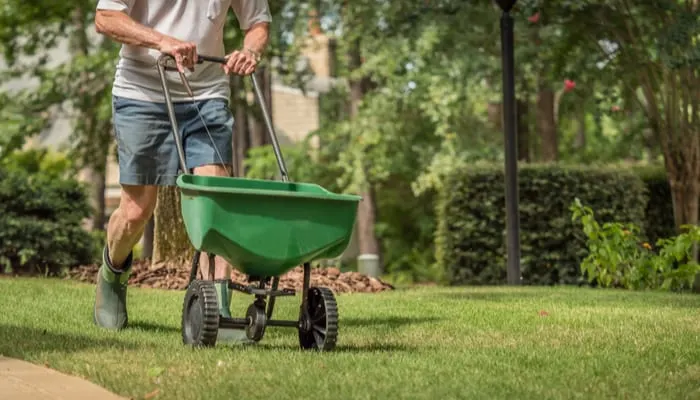
The Toidi/Shutterstock
Want a better way to get rid of goat heads? Calling a professional lawn care company is the most effective method. After all, they have the chemicals, experience, and knowledge to rid your lawn of this pest.
Simply enter your information into the form below, and you’ll be connected with at least one local lawncare company. Even better? They can give you a free quote for treatment. There’s no reason not to try it out!
How Will You Get Rid of Goat Head Weed?
The goat head is a worthy opponent for even the most determined and resourceful gardener. But its burrs are so painful and destructive that the opportunity to eradicate them is worth a lot of effort.
Fortunately for you, we’ve highlighted the best ways to get rid of it. If you’ve ever encountered this common weed, let us know in the comment section below!

